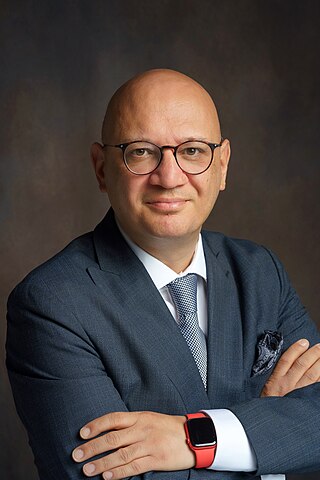
Nordea Bank Abp, commonly referred to as Nordea, is a Nordic financial services group operating in northern Europe with headquarters in Helsinki, Finland. The name is a blend of the words "Nordic" and "idea". The bank is the result of the successive mergers and acquisitions of the Finnish, Swedish, Danish, and Norwegian banks of Merita Bank, Nordbanken, Unidanmark, and Christiania Bank og Kreditkasse that took place between 1997 and 2001. The Nordic countries are considered Nordea's home market, having finalised the sales of their Baltic operations in 2019. Nordea is listed on Nasdaq Nordic exchanges in Helsinki, Copenhagen, and Stockholm and Nordea ADR is listed in the US.

Skandinaviska Enskilda Banken AB, abbreviated SEB, is a Swedish bank headquartered in Stockholm, Sweden. In Sweden and the Baltic countries, SEB has a full financial service offering. In Denmark, Finland, Norway, Germany, and the United Kingdom, the bank's operations are focused on corporate and investment banking services to corporate and institutional clients. The bank was founded in 1972 by the Swedish Wallenberg family, which is still SEB's largest shareholder through major investment company Investor AB. SEB is the largest Swedish bank by both market capitalisationand total assets.
Hansa Group or Hansabank Group was a banking group operating in Estonia, Latvia, and Lithuania owned by the FöreningsSparbanken/Swedbank, a Swedish bank. Following a decision taken by the Swedbank group on 15 September 2008, the name Hansapank/Hansabanka/Hansabankas or Hansabank internationally was discontinued end of 2008 with all operations rebranded under the Swedbank name. The legal name of the bank changed in spring 2009.

Swedbank AB is a Nordic-Baltic banking group based in Stockholm, Sweden, offering retail banking, asset management, financial, and other services. Swedbank has a leading presence in Estonia and has a strong presence in Latvia and Lithuania.

SEB Pank is an Estonian bank, owned by the Swedish bank SEB. SEB is the second largest bank in Estonia and is a member of the international SEB Group. Until 11 April 2005 the name of the bank was Eesti Ühispank, which was originally founded in 1992 from a merger of 10 smaller banks. On 7 March 2008, the bank changed its name to SEB Pank.

SEB banka is one of the largest banks in Latvia and a part of the Swedish SEB Group. Nowadays, its main rivals in the Latvian banking market are Swedbank, Luminor and Citadele bank.

Danske Bank A/S is a Danish multinational banking and financial services corporation. Headquartered in Copenhagen, it is the largest bank in Denmark and a major retail bank in the northern European region with over 5 million retail customers. Danske Bank was number 454 on the Fortune Global 500 list for 2011. The largest shareholder with 21% of the share capital is A.P. Moller Holding, the investment holding company of the Maersk family.
Rietumu is a Latvian private commercial bank founded in 1992.
The Big Four is the colloquial name given to the four main banks in several countries where the banking industry is dominated by just four institutions and where the phrase has thus gained relevance. Some countries include more or fewer institutions in such rankings, leading to other names such as Big Three, Big Five, or Big Six.
AS PrivatBank is a credit institution registered in Latvia as joint stock company and received its banking license on 31 July 1992.
A bad bank is a corporate structure which isolates illiquid and high risk assets held by a bank or a financial organisation, or perhaps a group of banks or financial organisations. A bank may accumulate a large portfolio of debts or other financial instruments which unexpectedly become at risk of partial or full default. A large volume of non-performing assets usually make it difficult for the bank to raise capital, for example through sales of bonds. In these circumstances, the bank may wish to segregate its good assets from its bad assets through the creation of a bad bank. The goal of the segregation is to allow investors to assess the bank's financial health with greater certainty. A bad bank might be established by one bank or financial institution as part of a strategy to deal with a difficult financial situation, or by a government or some other official institution as part of an official response to financial problems across a number of institutions in the financial sector.

ABLV Bank was one of the largest private banks in the Baltic States, headquartered in Riga, Latvia with representative offices abroad from 1993 to 2018.

AS Citadele banka is a Latvian bank and financial and asset manager. The principal market of operation for the Citadele Group is the Baltic States.

Bolt is an Estonian mobility company that offers ride-hailing, micromobility rental, food and grocery delivery, and carsharing services. The company is headquartered in Tallinn and operates in over 500 cities in more than 45 countries in Europe, Africa, Western Asia and Latin America. The company has more than 150 million customers and more than 3 million driver and courier partners. The company has plans for an initial public offering in 2025.

Luminor Bank AS is a bank headquartered in Tallinn, Estonia, with branches in Latvia and Lithuania. It is the third-largest bank in the Baltics and in Estonia. Luminor has a deposit market share of 16% and lending market share of 22%.
Banking in Estonia covers banking in Estonia. Banking started with the establishment of the central bank, the Bank of Estonia in 1919. It lost control during the Soviet period when banking was controlled from Moscow by Soviet powers. It was reestablished in 1990. As of 2022 it consists of the central bank and a number of commercial banks providing banking and financial services. Many of the commercial banks operating in Estonia are foreign banks primely from Scandinavia.

Ekmel Cilingir is a Turkish banker who spent much of career working in Malta and serves as the Chairman of supervisory board of Lithuanian bank EMBank.








